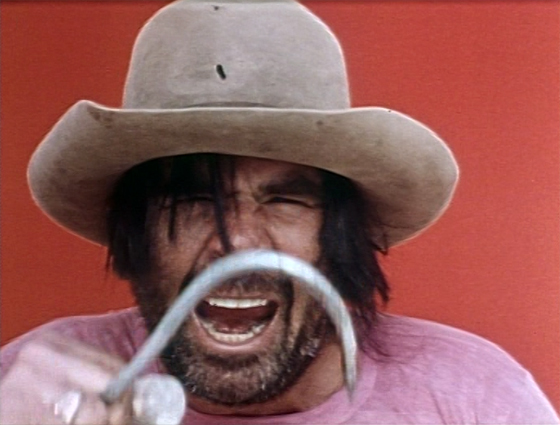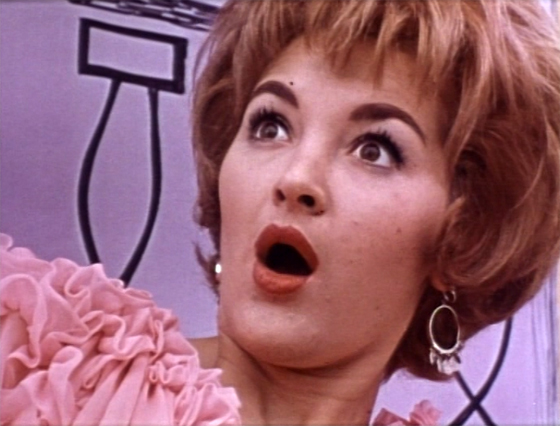
Perhaps Russ Meyer’s The Immoral Mr. Teas (1959) wouldn’t automatically spring to mind when considering the most influential and important films of the 1950’s, but it reserves a certain special place in cinematic history for one simple reason: it elevated the still-nascent “nature film” into a narrative, one with no moralizing message tacked on at the end. It wasn’t much of a narrative, I’ll grant you: a sexually repressed beanpole becomes overstimulated by the large-breasted pin-up girls that populate his workaday world. But the film boldly crossed that arbitrary line of morality drawn by the establishment: if you’re going to have nude girls, the film had better be educational. (To which exploitation filmmakers responded, “What’s more educational than documentaries about naturism? Long scenes of nude girls playing tennis, for example?”) Russ Meyer and producer Pete DeCenzie set out to make a naturism movie with a plot, and so was born the “nudie-cutie,” a genre that played gangbusters across the country. There was no pretense of educating or moralizing. It was right there in the title: this was immoral filmmaking. Flush with success, Meyer followed up Teas with Eve and the Handyman (1960) – starring his wife, Eve Meyer – and Erotica (1961), each film now facing competition from a flood of imitators. Wild Gals of the Naked West (1962) marked the last of his collaborations with DeCenzie, partly because, as Meyer biographer Jimmy McDonough notes in Big Bosoms and Square Jaws, “[DeCenzie] complained that RM was holding back on the money shots by keeping the females in pasties.” (I should note, because such things are important, that some of the performers in the film are in fact pasties-free.) He would linger in this ephemeral genre a little longer before heading into the second, and cult-iconic, phase of his career, faster pussycats and all.
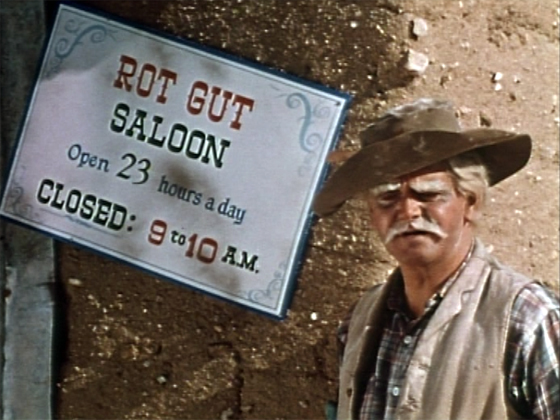
Russ Meyer's screenwriter Jack Moran recounts ribald tales of the Wild West.
Of his surviving nudie-cuties, I like Wild Gals the best. I kind of sort of love it. But wait – let me explain. This is a micro-budgeted, borderline-home-movie, probably-shot-on-a-weekend, candy-colored, corny-humor burlesque show which sees Meyer growing more confident in his triple-duty of photographer, editor, and director. It’s a full-bore explosion of Meyer’s Id, and what makes his films so fascinating is that the explosion wouldn’t abate for the next two decades – his Wild West would only get wilder from here on out. He begins with one of his many calling cards, an industrial film-styled narrator, this time reading a monologue about America’s pioneer past, over shots of ghost towns and half-toppled cabins, before briefly, hilariously abandoning his desolate landscapes and flashing into the present with shots of “Denver! Las Vegas! SAN FRANCISCO!” – just because. Then we’re back to the old West, the O.K. Corral, and, instead of actors and horses, we’re treated to impressionistic shots of streams of paint flowing into a river (to represent “painted men”), a flag, a spear, sound effects of gunshots, and a first-person view of stumbling into the tumbleweeds to die, since, you know, Meyer isn’t on John Ford’s budget here. Finally a shotgun leans toward us from out of a dark window. Then out of the cabin emerges our host for this evening’s entertainment, an Old Prospector Type played by the film’s co-writer, Jack Moran, who would go on to write Faster, Pussycat! Kill! Kill! (1965) and a few other Meyer 60’s films. His makeup is terrible. We accompany him to a saloon, only to discover he’s arrived at the one hour it’s closed (between 9 and 10am), so he sulks outside and dreams of the days when this town was so much better – more violent and immoral.
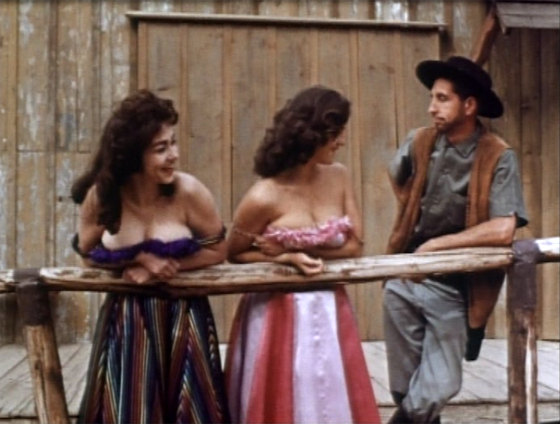
Meyer populates his nudie-cuties with burlesque performers, pin-up models, and war buddies.
Cut to breasts. The trenchcoat crowd heaves a sigh of relief. The rest of the film is essentially R-rated Looney Tunes, with Meyer repeating the same brief sequences over and over, escalating his gags minutely with each pass. Two cowboys fire at one another with guns, approaching each other slowly but missing each time. They run out of bullets and start slugging one another. A topless, golden-tressed girl is tied to a stake by an Indian who can’t get the fire at her feet started (eventually, bored, she just hands him a match). A man heads into an outhouse, and two old pranksters swap signs with the outhouse marked “Ladies.” A woman steps inside, and leaves a few minutes later with a smile. Then a line of women begins to form. Another girl tries to enjoy a glass of champagne, but a drunk cowboy keeps accidentally shooting it out of her hand, and she makes pouty faces. Three naked girls lasso unsuspecting passersby up onto their balcony. A man walks into a shack. A gorilla follows him, and leaves wearing his clothes. A girl walks into the shack, and the man leaves wearing her clothes. An Indian walks into the shack, it shakes back and forth, and the naked girl goes running out with the horny Indian hot on her tail. All of this is frequently interrupted by glimpses from a crazed saloon on an abstract, colorful set that seems to exist in some strange limbo between the Adam West Batman and Lars Von Trier’s Dogville: the backdrop is crudely drawn, the props deliberately phony, and the walls seem to change color from one moment to the next. These are rapidly-edited shots of Russ Meyer Pop Art: a grinning and toothless old woman (“Princess Livingston,” who would later show up in Mudhoney and Beyond the Valley of the Dolls); a menacing man with a hook (Meyer); firing revolvers; bottles being guzzled; grotesque masks; a grotesque mask and a hook; lovely ladies; jiggling breasts.
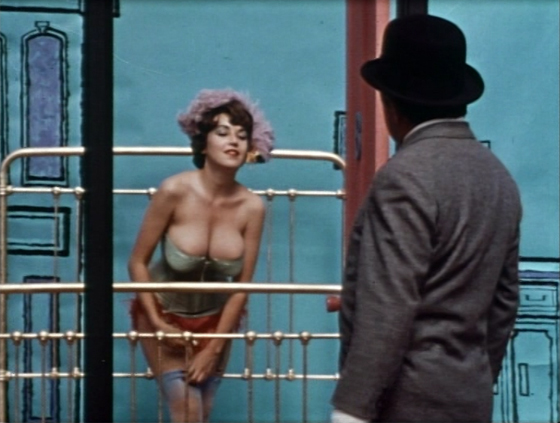
Sammy Gilbert is a Stranger who cleans up the town, resisting its many temptations.
The effect is some pre-psychedelic wonder which any head-trippers could enjoy, offering all the stream-of-consciousness juxtapositions, color, strangeness, and overstimulation they could possibly want. But this is just Russ Meyer being his booziest, reflecting his favorite environment: a corny, horny burlesque show, with risqué humor that nonetheless feels harmless and quaint. So you wouldn’t feel quite so sleazy going to Wild Gals of the Naked West – it’s all in good fun. A payoff to the film’s many running jokes comes in the form of a straight-laced Stranger (Sammy Gilbert) who is at first oblivious to the wanton lust and violence that surrounds him, but, eventually, cleans it all up – by handing some clothes to that girl using the bathtub in the middle of the street, to name one example. Despite his Do-Goodery, he does take one beautiful admirer to bed after his hard day’s work, which allows Meyer a parodic sex scene that plays out in overwrought visual symbolism, years before Monty Python made the same joke (though Python did it better). Our narrator is dismayed by how the town changed in the Stranger’s wake, opining that we all ought to have just “a twinge of meanness…something for the good to work against.” So you see? Russ Meyer could offer a moral after all.
